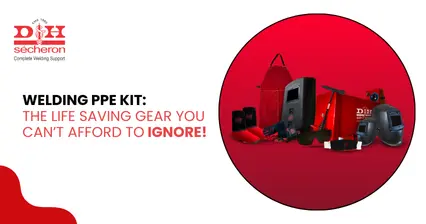Back to Welding Basics: A Guide for Beginners
“Everything in life goes back to basics”, says the MMA artist Kron Gracie.
While his skill set lies elsewhere, this quote stands true for the world of welding as well. To have great expertise, one needs to know the welding basics in and out.
What is Welding?
To start off our discussion on welding basics, here’s a simple definition of welding.
Welding is the process by which two or more parts of a material are joined together by the means of heat, pressure or both. The most commonly welded material is metal.
Welding Basics: Terms and Terminologies
To be thorough in welding basics, there are certain terms you need to be familiar with. These are:
Parent or Base Metal: The parts of metal that are going to be welded.
Weld: This part of welding basics, obviously, is the part where the metals have been fused together. The welded joint, sometimes, is also referred to as the weldment.
Filler or Consumables: The material required for the joining of the metal parts, like welding flux, are called fillers or welding consumables. They can further be divided into conventional welding consumables and reclamation welding consumables.
Welding Arc: All types of arc welding: SMAW, SAW, FCAW, MIG and TIG Welding, work in the concept of an arc in welding. An arc, simply put, is the electric discharge between two electrodes.
Welding Fixture: These are devices used to hold the parent metal and other parts in a steady position. This ensures the safety of the welder and a clean weld.
Welding Basics: Equipment and Materials
As you study and practice welding, you’ll realize that the know-how of your equipment is a quintessential part of welding basics:
Welding Rod: A welding consumable that comes in the form of a rod or wire.
Acetylene and Acetone: Another part of gas welding basics, are these two materials. Acetylene is a highly flammable gas that is used in gas welding. It is made of hydrogen and carbon. A welding torch is used to control the flow of the gas. Acetone is a liquid that is used to dissolve as well as stabilize Acetylene.
Welding Electrode: A welding electrode is a rod which carries the current to have sufficient heat for the process of welding. The current moves between the electrode holder and the arc. Another common type is flux-covered electrodes.
Flux: Welding flux is a mixture of materials, typically carbonate and silicate, that are used to shield the arc. Welding basics 101: the most important part welding flux plays is to protect the weld metal from contamination by atmospheric gases.
Welding Basics: Safety Equipment
The most overlooked yet the most important part of welding basics is the safety aspect of it. Many welders often skip one part of the equipment or another. Here is a list of welding safety equipment every welder must use:
Welding Gloves
Welding Helmet with eye protection
Welding Boots
Pants with no cuffs for welding
Welder’s Jacket which is heat resistant
Respirators for lung protection
Ear plugs
Here ends the guide to welding basics for a beginner welder. For more details on welding, including 360-degree welding support, visit D&H Sécheron - India’s leading welding consumables manufacturer.
13 May 2025 | Welding
An In-Depth Exploration of Low-Alloy Steel: Your Comprehensive Guide
13 May 2025 | Welding
Nagpur - Bori - Tuljapur Road MSH-3 in Yavatmal District (Maharashtra)
13 May 2025 | Welding
Guidelines to Understand Gas Welding: Applications, Advantages & Disadvantages
13 May 2025 | Welding
3 Tips for Finding the Best Mild Steel Electrode for Your Application
13 May 2025 | Welding
How to Select the Right Welding Filler Wires for Stainless Steel Welding?
13 May 2025 | Welding
Building the Narendra Modi Stadium with Norma V and Autotherme-1 Electrodes
13 May 2025 | Welding
Low Alloy Steel Welding in a (PEB) Pre Engineered Building Structure
13 May 2025 | Welding
Welding Rods: Different Types and Tips for Properly Storing and Handling
13 May 2025 | Welding
Tips for Flawless Welds with Stainless Steel Electrodes: Pros and Cons
13 May 2025 | Welding
Exploring Applications and Benefits of Stainless Steel Welding Electrodes
13 May 2025 | Welding
Distinguishing Low-Alloy Steel from High-Alloy Steel: Understanding the Variations
13 May 2025 | Welding
Hard Facing Wire - Understanding the Process and Achieving Optimal Result
13 May 2025 | Welding
Exploring the Advantages of Stainless Steel Electrodes in Welding Applications
13 May 2025 | Welding
Weathering Steel vs. Traditional Steel: A Comparative Analysis of Performance
13 May 2025 | Welding
Choosing the Right Welding Rod: Why 6013 Electrodes Might Be Your Ideal Option
13 May 2025 | Welding
Why 7018 Electrodes Are Preferred for High-Strength Welds in Pipeline Construction
13 May 2025 | Welding
Filler Wire vs. Stainless Steel Filler Wire: Understanding the Key Differences
13 May 2025 | Welding
Exploring the Impact of Filler Material on Welding Quality and Durability
13 May 2025 | Welding
Choosing the Right Cast Iron Electrode for Different Welding Projects
13 May 2025 | Welding
Top Advantages of Cast Iron Electrodes for Industrial Welding Applications
13 May 2025 | Welding
Key Benefits and Challenges of Using TIG Welding in Industrial Projects
13 May 2025 | Welding
5 Reasons Why 7018 Electrode is the Gold Standard for Welding Professionals
13 May 2025 | Welding
Top 5 Advantages of Flux Cored Arc Welding for Heavy-Duty Applications.png)
13 May 2025 | Welding
Lotherme-601: A Game-Changer for Restoring Shoulder Pins in Heavy Machinery
13 May 2025 | Welding
How D&H Sécheron Helped Repair a Rotary Kiln’s Cooler Section with LoTherme 352
13 May 2025 | Welding
Piston Repair for Mining Industry: Cost-Effective Solutions with LoTherme 468.webp)






.jpg)








































.jpg)
.jpg)

.jpg)

.jpg)





.jpg)
.jpg)
.jpg)



.webp)
.jpg)
.jpg)
.webp)
.jpg)






















.png)



.webp)

.webp)
.webp)



